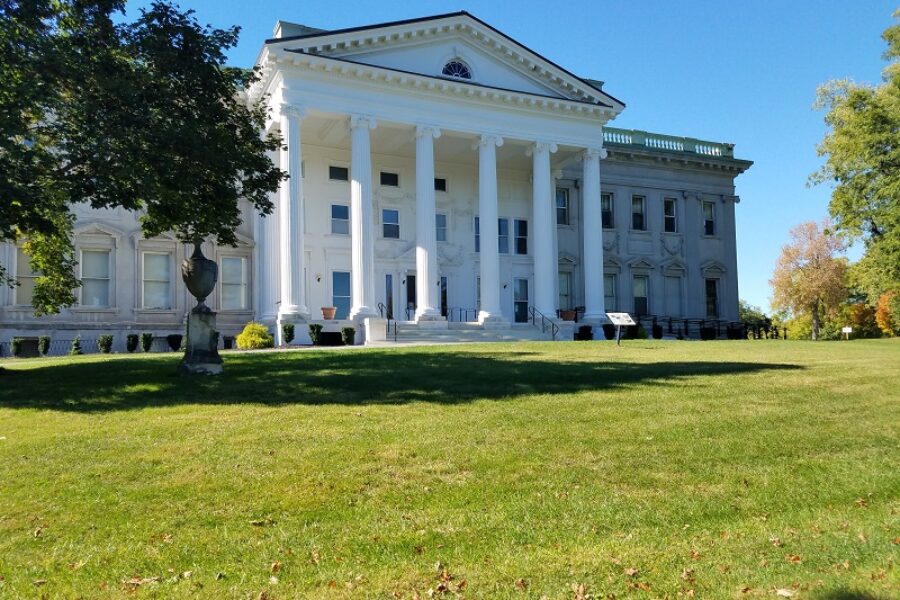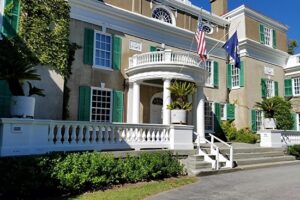Before starting our tour of the Vanderbilt Mansion in Hyde Park, I have to look at the gift shop. Many things appeal to me, but I particularly LOVE the globe mobile. I just can’t figure out where in the world I’d hang it. So I play with it and twirl it and think. Then I move on to the books and The Art of Afternoon Tea.



Our guide is chatty and knowledgeable, and as we stand here under the two-hundred-year-old locust tree—heavy with beans so large and in such abundance that they look like curling snakes hanging from the limbs—I feel like a friend is giving me the lowdown on a new neighbor, not a Park Ranger giving me a lecture. i.e., Did you know Louise is a divorcee, and Frederick’s father disinherited him when he married her? …and if it weren’t for his sister saying, Gee Dad, he’s in love, and he’s the only one of us that has gone to college…and he really is a good kid…and he does work hard… that eventually the Father took Frederick back into the fold and left him $10,000,000 at his death. A paltry sum compared to that which his brothers received.

What I can’t figure out is how and why this Gilded Age country home is part of the National Park Service. Before I can ask the question, I’m given the answer. Apparently, it all came down to timing and neighbors. The home was completed in 1899 at an estimated cost of $2,500,000, and the childless Vanderbilt couple, Frederick W. and Louise, owned it till Frederick’s death in 1938 when he left it to a niece. She did not need the estate nor want to pay the upkeep, so she put it on the market for $350,000 (the U.S. was still reeling from the Depression)—fully furnished. There were no takers. A year later, she lowered the price to $250,000. Still, no takers. She confessed her woes to her neighbor Franklin Delano Roosevelt, and he persuaded her to donate the home and grounds to the Parks Service to be used as a perfect example of the way people lived during the Gilded Age. Everything is intact and untouched.
We are about to enter another time capsule.
It looks like a bank. It looks like something that will last forever. Our guide tells me that the steel structure holding up the residence was in a state of decay and had to be reinforced—so much for outward appearances.


Today’s drill is almost the same as yesterday. All fifty of us walk into a central foyer—the location for before dinner cocktails for lucky guests in the Gilded Age. We all politely try not to get in each other’s way as we politely jostle elbow to elbow, trying to see in all of the rooms beyond a velvet rope that keeps us at the threshold before time is up. There are a lot of thresholds and velvet ropes down here in this fifty-four room mansion—I mean country cottage.
You either have to be the first one in or the last one out to get a picture without a crowd!






The wealth and the excess are overwhelming; the remnants of a lifestyle I see before me—where women changed their clothes ten times a day—is one I can’t conceive no matter how hard I try. But still, it’s fun to look. After examining the second-floor bedroom suites, we wind our way down to the basement, where the servants reigned. I feel much more comfortable down here, especially in the kitchen, which I can only glimpse. Just as I get ready to snap a picture of the copper pots, my phone rings. I answer, sneaking off down a short hallway, whispering a quick conversation with my friend Vivian.






Outside, on our own, Michael finds a bench on which to sit and look beyond the trees to the river. The sun chases us into the shade and down a long path to the formal gardens.



On our way back to the car, I tell Michael I want to run into the gift shop—I need to buy something. I greet him on the lawn with a package in hand. “Where is the globe mobile,” he asks. He knew I loved it.
As Michael drives up 9G, I sit with book in hand and begin planning the perfect afternoon tea with friends. Perhaps I’ll host a Downton Abbey Tea, with a viewing of the very first episode—perhaps the last?









Leave a Reply
Your email is safe with us.